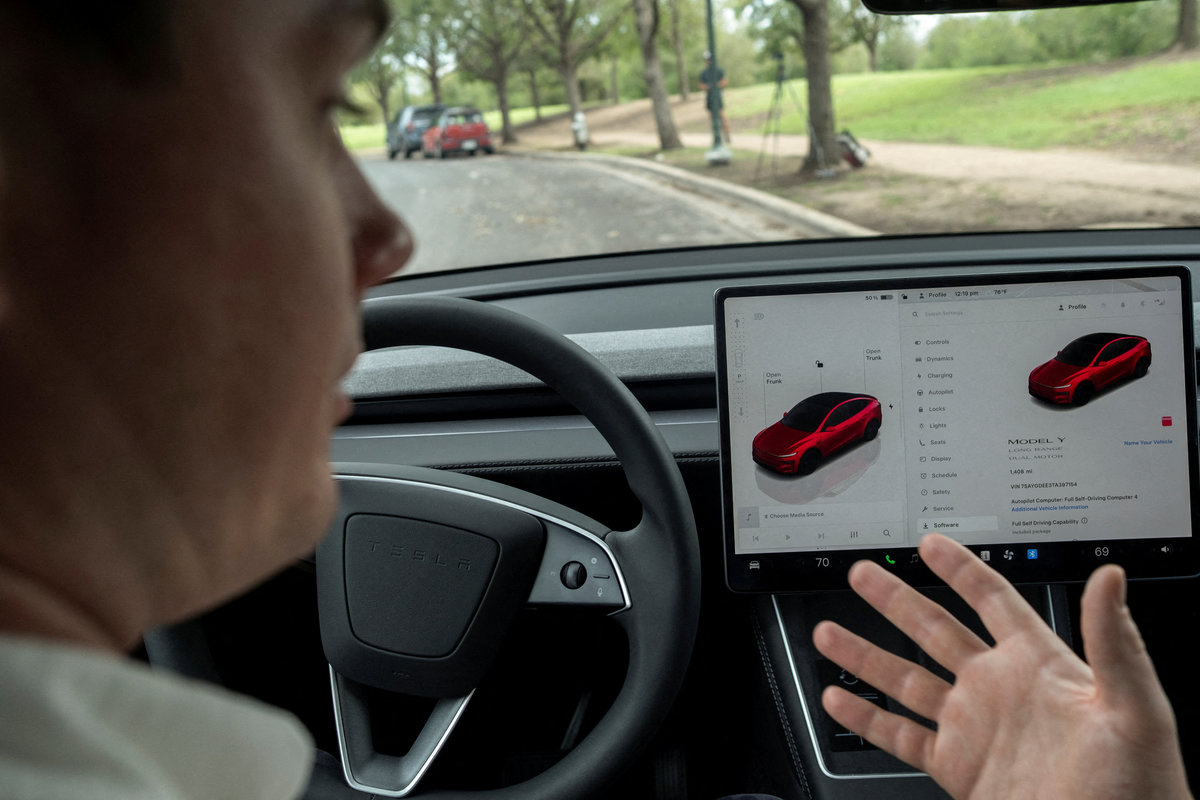A first public test of robotaxis by Tesla in Austin, Texas led to multiple traffic problems and driving issues, videos from company-selected riders showed over the first few days.
Chief Executive Elon Musk has tied Tesla's financial future to self-driving technology, and with Tesla sales down, the stakes are high.
He said Tesla would roll out the service to other U.S. cities later this year and predicted "millions of Teslas" operating "fully autonomously" by the second half of next year.
The Tesla fans invited to the trial were strongly supportive and posted videos of hours of trouble-free driving, but issues drew questions from federal road safety regulators and auto safety experts.
Issues included Tesla robotaxis entering the wrong lane, dropping passengers off in the middle of multiple-lane roads or at intersections, sudden braking, speeding and driving over a curb.
In one instance, a robotaxi drove into a lane meant for oncoming traffic for about 6 seconds.
It had pulled into an intersection in its left-turn lane with its turn blinker on.
Then the steering wheel wobbled momentarily, and instead of turning it proceeded straight into the lane meant for oncoming traffic, prompting a honk from a car behind it.
In another incident, the car suddenly braked with no obstruction apparent in the video.
The passenger jerked forward and their belongings were thrown to the floor. In a third video, taken from another vehicle, a robotaxi abruptly stopped twice in the middle of the road while passing police vehicles with flashing lights.
Tesla is conducting the test with human safety monitors in the front passenger seat.
A fourth video showed the safety monitor hitting a button to stop the robotaxi when a delivery truck in front of it started backing up.
"This is awfully early to have a bunch of videos of erratic and poor driving," said Philip Koopman, a Carnegie Mellon University computer-engineering professor and autonomous-technology expert.
"I was not expecting as many videos of problematic driving on the very first day," he said.
Tesla is testing about 10 to 20 robotaxis, which are standard Model Ys with advanced software, and has been giving rides since Sunday afternoon.
Reuters was able to independently verify the locations of at least 11 videos showing issues.
Tesla did not respond to a request for comment.
A City of Austin spokesperson said officials are aware of the Tesla issues documented on social media and that "when a potential legal or safety concern is brought to our attention, we promptly share it with the company."
The spokesperson added that the police department is "actively collaborating with Tesla" to ensure officers can safely interact with the robotaxis.
'CAUGHT ON CAMERA'
The incidents caught on camera did not involve accidents, and one expert said some reflected a decision to focus on safety.
"So far so good. It handled the situations very well and likely better than even good drivers," Alain Kornhauser, Princeton University professor of operations research and financial engineering, said by email.
He added that it would be more dangerous to drive at less than the speed of prevailing traffic, for instance. Tesla's experiment is unusually public.
Other companies faced similar issues:
Alphabet's Waymo and General Motors' Cruise had their own share of traffic mishaps after showing up on Austin streets.
City officials logged dozens of instances over the past two years where residents and authorities reported that robotaxis blocked traffic by stopping in the middle of roads, failed to respond to police directions and could not deal with emergency vehicles and road closures.
A serious accident involving a pedestrian in 2023 led Cruise to shut down last year.
Waymo is the only robotaxi service in the U.S. to ferry paying customers without a human backup driver or in-car safety monitor. It started offering rides to the general public through Uber in Austin earlier this year.
Musk for years has failed to deliver on promises that self-driving Teslas are just around the corner.
Tesla rolled out the service for a flat fee of $4.20 to a limited number of handpicked riders.
The service is not available to the broader public and the robotaxis operate in a limited area, and avoid difficult intersections and bad weather.
Riders were rarely bothered much by driving issues.
Farzad Mesbahi, a former Tesla program manager, and his co-passenger hit the "drop off early" option during a ride. The vehicle stopped in an intersection with a stoplight, his video showed. They exit quickly and walk to the sidewalk.
"The car should have known to not stop there," Mesbahi is heard saying after the ride. "Opportunities for improvement," the co-passenger says.
That is an example "most companies would not be comfortable with," said Kara Kockelman, a professor of transportation engineering at the University of Texas at Austin, adding that she was surprised by the traffic mistakes.
"Dropping off people in the middle of a six-lane road or edge of a busy intersection when the traffic is going in the opposite direction is pretty dangerous.
They definitely did not want to do this or be caught on camera," she said.









